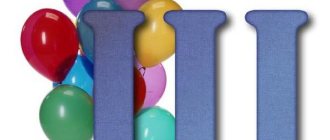Article:
One of the most controversial issues for parents and teachers is whether it is necessary to teach schoolchildren to read quickly. Teachers have their own opinion on this matter - the main thing is that the child reads correctly, and not quickly. It is better to start teaching speed reading skills when the child already knows how to read and does not make mistakes. Otherwise, the student will begin to rush and become inattentive. It seems that he is engaged in reading, but he does not remember what he read.
Speed reading and its types
There are only three types of speed reading:
- Analytical. There are principles and approaches here. It is the most difficult of all and the slowest, since you need to absorb all the information and understand it. Reading speed does not exceed 3000 characters per minute.
- Introductory. Lighter look compared to the previous one. This reading technique is especially useful if you already have a structure of knowledge in your head and you just need to supplement and expand it. This technique is suitable for reading light literature and news. Reading speed is about 5000 characters.
- Search engine. This is the fastest way to read. It makes it easy to find the desired piece of text. Also great for brushing up on existing knowledge. Reading speed can reach 14,000 characters per minute.
A person can master all three techniques and use them as needed.
How to master speed reading at home
Now there are a large number of specialized courses that teach this skill. The duration of the program can be 2-6 months. You can also find free courses on the Internet; there are specialized websites for this, where training programs are laid out in detail.
Is it possible to learn speed reading at home? The question is very complex and largely depends on the child and his abilities. It will be easier for a schoolchild to study in real conditions, since children at this age will develop a competitive trait. Many children find it easier to study under the supervision of a teacher who can advise, guide and help with this.
At what age to start
You can hear a widespread opinion that you can start teaching your child speed reading techniques at any age, since indirectly it develops attentiveness and improves memory. Experts have the opposite opinion on this matter and are convinced that this reading technique is suitable for children over 14 years of age.
During this period, teaching of various sciences begins at school. Physics, chemistry, algebra and other complex subjects appear. Schoolchildren are faced with the problem of mastering large amounts of knowledge in a short period of time. This is why these useful skills come in handy: reading a large amount of information and at the same time assimilating it well.
When engaging in speed reading with a child at an early age, there is a risk of developing the wrong cognitive strategy. First of all, you must read correctly and correctly.
If by the age of ten there are no problems with reading, you can begin to increase your speed. It is important to understand that speed reading does not teach you to read, but rather teaches you how to do it as efficiently as possible.
According to the Waldorf school
This school involves the all-round development of the student. The emphasis is on maximum knowledge of the exact sciences and humanities. Training in speed reading skills begins at the age of 5-7 years and is very intensive. The Waldorf school and its teaching methods are common in some European countries. There are very few such schools in Russia; they exist only in some cities of the Russian Federation.
According to Zaitsev's method
This technique is based on “Zaitsev’s cubes” and is designed for teaching reading to children over two years old. It can be used in kindergartens, schools, and at home. Shows good results when working with children with developmental disabilities - ODD, mental retardation, alalia and other speech and mental disorders. The Zaitsev method is used in working with children with visual and hearing impairments.
The training is based on the analytical-synthetic method - the use of stackable blocks in a playful way.
The letters are large in size and can be seen even from a distance of several tens of meters. This is necessary so that children do not have difficulty looking at them. The cubes themselves are painted in different colors - red, gold, green and others, while they are all different sizes and have fillers inside that make characteristic sounds when shaken. This is done with the aim of quickly and reliably memorizing sounds, letters, and syllables. This technique has a number of other positive effects:
- develops writing skills;
- corrects speech therapy speech defects;
- speech becomes clear and intelligible;
- vocabulary increases;
- logic develops;
- independence of learning develops.
There are statistics about when children start reading. Children aged 2-4 years begin to read after 6 months of classes. Children over 4 years old after 16 lessons. Children six years old can start reading after just 6 lessons.
Montessori method
The goal of this technique is to create an environment where the child will develop with minimal adult intervention, but under his control. The child chooses the activity and duration of training. In practice, this is a space that is maximally adapted for a child, taking into account his age, physiology and other individual characteristics.
He has at his disposal all the toys with which he can perform any manipulation. Classes are held in this space. It is divided into five zones that are responsible for your side of the personality:
- practical life zone;
- sensory development;
- math zone;
- natural sciences zone;
- speech development.
Nowadays a huge number of such children's centers have appeared, but it is difficult to find a really good one. This is due to the shortage of specialists who know the Montessori method perfectly.
Andreev's Speed Reading Method
This technique was developed by Oleg Andreev. It allows:
- increase reading speed by more than five times;
- improve reading comprehension;
- retain acquired knowledge in memory;
- improve attention;
- increase interest in the learning process.
Andreev’s programs consist of several classes:
- sprint;
- dominant;
- satori;
- fifth way;
- sixth sense;
- Fourth dimension.
The method consists of constant training. Gradually, the child stops reading words and perceives them as pictures. This greatly and quickly increases your vocabulary. Those who have gone through this technique read several times more books than their peers.
Lysenko's technique
This program was developed by Olga Lysenko, a teacher with more than 20 years of experience. Her method consists of four courses:
- multiplication table;
- ABC;
- beautiful handwriting;
- reading without syllables.
After completing all the courses, the child will quickly learn to write, read, and add numbers well.
Doman's technique
Consists of a set of physical and intellectual exercises and simulators. Doman is a proponent of the theory of the connection between physical development and mental development. By doing physical exercises, parents simultaneously stimulate his mental development. The methodology is based on classes aimed at all aspects of the child’s development.
Gorbov-Schulte tables
This is a test to assess the ability to shift attention. It is often used by psychologists to assess concentration. The table consists of red and black cells.
An example of a Gorbov-Schulte table for speed reading training.
Why read quickly?
With each grade, the amount of information that a student needs to learn increases. Without the ability to read quickly, this will become more and more difficult each time. Speed reading and memory development are closely related. When a child reads well, it is easier for him to remember the text and retell its content. His success in teaching any subjects depends on this.
Those children who read slowly and without desire cannot cope with a large flow of information. And accordingly, they begin to lose out in knowledge to their peers who can do it quickly. The importance of the ability to read quickly should not be overlooked for the effective acquisition of knowledge throughout life.
It is important to understand what speed reading does for a child. This useful and necessary skill helps:
- understand any text at the mental level, analyze, highlight the most important things and briefly retell what you read;
- quickly remember any acquired knowledge;
- develop the brain’s ability to absorb large amounts of information;
- increase reading speed by 5-10 times;
- instill interest in learning and reduce the time spent on completing educational tasks;
- develop competent writing skills;
- become more confident in yourself.
The ability to read quickly lays the foundation for success in a person from childhood. Having mastered the technique of speed reading, it remains forever and it is impossible to lose it over the years.
In order for speed reading classes to be beneficial, it is important not to overload the child’s brain and not force him to do it. The best solution would be to start classes when the children want to study and understand why they need it. At the same time, it is necessary to provide texts of age-appropriate complexity for reading and studying.
Don't Make These Mistakes
When starting to teach their child speed reading, parents make some mistakes. Subsequently, speech therapists and child psychologists spend a lot of time correcting them. Experts have developed some of the most common mistakes that can be avoided.
Children face the following problems:
- Articulation when reading “to oneself”. There is movement of the lips and tongue. This occurs in 80% of adults; they pronounce the information they are reading, while their eyes remain in one place for a long time. Articulation greatly reduces reading speed. The speed reading technique allows you to “scan the text.”
- Many people rely on hearing when vision allows them to read material tens of times faster.
- Insufficient field of view.
- While reading, a person spontaneously makes movements with his head and neck. All this also reduces reading speed.
Almost all techniques are designed to eliminate these phenomena or significantly reduce their manifestations.
Tell the baby a letter, not a sound
The baby must understand a specific sound and imagine it as a letter. To “get acquainted” with a sound, the parent needs to say it many times. You can use rhymes, tongue twisters, songs in which this sound occurs. Accordingly, show the letter that means this sound.
Compose syllables from individual letters
Some methods do not include learning letters. They begin the process with words, as in the Doman method. Zaitsev’s method involves studying warehouses using special cubes. Before starting to teach reading, the child must know all the letters well and only then begin to add them into syllables and words.
They read texts for a long time
Parents read one text many times, so they lose interest in it. You need to use different books or different reading passages to prevent this from happening.
Technique "Lightning"
The use of the Lightning technique is as follows. Children are shown a word for a very short time, and they must have time to read it. For this exercise, you can prepare flashcards or create a presentation in which words appear and disappear after a couple of seconds.
The same set of words should be used for several days in a row until the students remember them all. Then offer another selection of words. For a better effect, you can not just let schoolchildren read the word, but also ask them to write it after it disappears.
Exercises for first graders
Classic speed reading is designed for children over ten years old. They contain classes to eliminate pronunciation. There are a number of techniques that are designed for first graders that can increase reading speed, improve a child's memory and attentiveness.
Automated syllable reading
A child who cannot add syllables simply tries to guess the correct option, using the semantic context to help. This leads to a large number of errors and slows down reading development. To prevent this from happening, it is necessary to use syllabic material for learning to read. It is impossible to guess the syllable this way.
The ability to read complex words gradually develops. This method is used for children suffering from dyslexia. In this case, teaching reading using classical methods is extremely difficult. For this, there are syllable tables that look like this:
The parent or teacher randomly points to a syllable and the child must read it. At first, tables of nine cells are used, gradually it becomes larger - 24, 36, 48. Thus, reading syllables becomes automatic.
Choral reading
This technique has long been included in the tools of the Russian classical school. Ushinsky K.D. recommended choral reading to enliven the class and relieve fatigue.
Choral reading is an active and effective form of teaching how to read with expression. Reading poetry affects the quality of speech, correct pronunciation appears, and hearing develops. In this form, poems or songs are better remembered. This affects memory in general and helps to pronounce words and individual sounds correctly.
Task "tug"
This task is used to improve your reading speed. The leader is an adult or student with a high reading speed. He reads the text, the others must keep up with him. This exercise is carried out in primary classes and kindergarten groups.
You can make sudden stops that other readers do not expect. The presenter may deliberately make mistakes that other readers should point out.
Jump-stop
With the command "jump", the child should start reading until he hears the command "stop". He stops reading and looks away from the book or closes it. The next time he jumps, he must start from where he left off.
Half
A word cut in half is shown on the monitor screen or paper cards, and the child must guess what kind of word is depicted in this picture.
Speed reading for children over 8 years old
The exercises used to teach speed reading techniques are designed for a certain age of the child. For children 8-10 years old there are their own exercises. They can be done at home with the help of parents. They are also used in specialized centers that teach this skill.
Insert letters
This exercise improves the child’s visual memory, teaches him to analyze what he read, develops the skill of relating the first and last letters of a word and creating a visual image of what he read in his head. This way he remembers better what he read.
On a piece of paper, print out a fragment of text in which vowels are omitted. The student must restore them. This task should take no more than 3-5 minutes (text of 3 sentences of medium length). Gradually the task becomes more complicated - entire words and phrases are skipped, and the allotted time is shortened.
Fixing the error
A teacher or an adult, when reading a book, intentionally makes mistakes, and the child must point them out and correct them. You can change endings, suffixes, and place accents incorrectly.
We are looking for a line
The student must find on the page of text all words beginning with the letter indicated by the adult. This trains attentiveness and the ability to concentrate.
Read at speed
The student himself measures his reading speed and keeps records of his achievements. In the second grade, the speed should be about 70 words and by the third grade it should increase to 100.
Hidden words
This activity is similar to reading anagrams. The child must form words from the letters drawn on the cards. At the initial stages, it is better to give him a list of hidden words. As you gain success, this is not necessary. Cards can be printed on plain paper or glued to a cardboard base.
Reading and counting
You need to read the text and at the same time count letters, words, punctuation marks, and the number of specific letters.
"Hidden Letters" Technique
Improving reading technique is facilitated by developing the ability to predict words rather than read them letter by letter. To do this, you can offer the following tasks:
- words with blots - a word is written on the card, part of which is covered by a blot;
- words with missing letters - there is a word on the card in which several letters are missing;
- cut word - a card with a written word is cut lengthwise and children are asked to read the word either along the upper or lower part (the word can not be cut into pieces, but cover half of it with a ruler);
- A more difficult version of this exercise is to predict the missing word. For it, you can use catchphrases, phraseological units, famous phrases from fairy tales or poems, riddles with rhyming answers.
Regression Suppression
Regression - returning your gaze to a read fragment of text. This happens uncontrollably in all people, which significantly reduces reading speed. To get rid of this, a number of special exercises have been developed.
Reading direction
Use a pencil or pen to follow the line, but only forward. This is how the child gets used to following the pointer and does not go back.
Close text
The text that has been read is covered with paper or a bookmark. The student places it at the top of the text and moves it down as he reads.
Speed check
You need to measure your reading speed every day. The resulting numbers are entered into a table. This is how progress and speed are tracked.
Articulation suppression
Schoolchildren cannot read without pronouncing the words to themselves, moving their tongue. For speed reading techniques, this needs to be corrected and eliminated. To combat this you can use:
Musical accompaniment
The text is read to the music. After a few lessons, music with words is turned on. It is advisable to use classical compositions. You should not include fast rhythmic compositions.
"Bumblebee"
When reading, the child is disturbed by a monotonous sound, similar to the buzzing of an insect.
Rhythm
During classes, an adult rhythmically taps his finger on a table or other object. Gradually the rhythm speeds up.
Lock
The child should purse his lips tightly and read to himself as quickly as possible. For additional effect, you can cover your mouth with your palm.
Take breaks
You need to practice for 10-20 minutes, giving the child time for a short break. After a good workout, the break should be 20-30 minutes, no less, so that the brain has time to form new neural connections. This greatly increases efficiency.
During the break:
- you cannot: read, write, watch TV, play games, sit with a phone or tablet.
- you can and should: relax, take a walk, breathe fresh air, eat (if it’s time, you don’t need to eat again), play with soft toys, drive the car, and so on.
Exercises for concentration
Attention training is a mandatory element of speed reading. You should not conduct such activities during important activities. You should also not combine them with other exercises. The center of attention of this complex is the “spotlight”. It should be aimed at one thing, and not scatter. To achieve this, exercises were created.
Exercise "Line"
A drawing is applied to a sheet of paper with a slow, continuous movement of the hand. It could be anything, like a lily flower. The child concentrates on this activity. As soon as the child thinks about something or gets distracted, the line will be interrupted. After the drawing is ready, adults count how many times the child was distracted from the lesson.
Colorblind
When reading, you need to name the colors rather than read their names. Not everyone succeeds the first time, but with practice, the child will be able to name all the colors without making mistakes.
Red. Green. Blue. Yellow. Violet. Orange. Brown. Blue.
Red. Black. Green. Blue. Yellow. Brown. Black. Green. Blue.
Violet. Blue. Yellow. Black. Red. Orange. Brown.
Concentration on fingers
The student sits on a chair, holds his neck straight, head raised. The index fingers of both hands make rotational movements. The fingers should not touch each other, the amplitude is as slow as possible.
clock hand
Attention is focused on the tip of the minute hand and for 3 minutes the eyes count how many times this hand has moved.
Bottom line
In this article, we discussed speed reading for children and learned that a child can be taught speed reading immediately after he learns to read whole words. And so that he can learn this faster, we have developed a special simulator that not only a child, but also an adult can train with!
Training on such a simulator helps you quickly learn to read words. All you need is to select the desired mode and start training. Don’t forget to sign up for our Speed Reading course in 30 days.
The Development of Ancipation
When reading a book, with peripheral vision the child should see the outline of the next word and guess what it is. Exercises have been invented for this.
- Ruler. Close the text for 10-15 characters, while the child should read at his usual speed.
- We read upside down. The text is first read in normal mode, then upside down, that is, vice versa. This exercise affects memory and attention. You can also rotate the book 90 degrees.
- Halves. Use a piece of paper to cover the line of text that the student is reading. You only need to cover the top or bottom of the letters; the child must guess which letters are written.
Reading with an adult
This is a way to teach a child to read quickly by imposing on him the high reading speed that an adult has. The student is forced to adapt to this pace, and over time he can maintain it. It can take three types:
- Parallel reading. The parent reads the book, constantly changing his speed, increasing and decreasing it. The student must place his finger in the right place and constantly monitor it, avoiding lags and advances.
- Relay race. The text is read in turn - by a schoolchild and an adult. The reader must be changed suddenly. If possible, the parent should speed up their pace.
- Tail. The adult begins to read, the child joins in a few words later. You need to read in a low voice. The task is not for both of them to go astray.
What slows down reading
Trying to teach your child to read quickly can face a number of difficulties. The main ones are:
- Articulation. Reciting what you read to yourself. This phenomenon applies to most adults as well. They do the same. This effect is a habit that is difficult to break.
- The eye does not have a sufficient viewing angle. A person sees only the area where his eye falls and a small area around.
- Regression. This is a popular flaw that affects reading speed.
All speed reading techniques reduce the influence of these factors and lead to an increase in reading speed.
Limited field of view
A wide viewing angle reduces the search for the desired fragment in the text. This angle is called the field of view, which can be expanded with special exercises - Schulte tables. Works with them are capable of developing parallel attention - symbols that are in the field of view are understood by the reader at the same time, but are recounted sequentially.
The main thing is to look at the center of the table and see the numbers located along its edges. With regular practice, reading speed increases due to the development of peripheral vision, that is, a person sees more text. A small angle allows you to see only one fragment of a page of text.
Problems
Training speed reading involves some difficulties. Unprepared children have poorly developed peripheral vision and articulation, and have defects in mental skills (attention, memory).
- Narrow field of view. To master the technique of fast reading, you need to have a wide range of vision. The eyes should not focus on one word. The task of a speed reading teacher is to teach the student to perceive the text as a whole, that is, the gaze should stop not on individual words, but on the spaces between them, immediately capturing a phrase or sentence.
- Eye regression. This is the main enemy of speed reading. The student returns to the text he has already read, wasting time. Eye regression occurs automatically. The process can be controlled using training exercises.
- Suppression of articulation. When reading at a normal pace, children try to pronounce words clearly and loudly. This helps to absorb fiction. For example, it is impossible to perceive poetry accurately and feel the author’s mood without pauses or logical stresses. But for dynamic reading, diction is not needed. Pronunciation reduces the speed of text comprehension.
- Undeveloped attention. High reading pace requires increased attention. This is necessary for instantly highlighting the main and secondary, deep understanding of new information.
To eliminate defects and develop fast reading skills, you need not only to constantly train, but also to adjust the width of your field of vision, give up internal pronunciation of words, control regression, and develop attention and memory. The following exercises will help with this, which are included in the training system, devoting a few minutes to them in each lesson.
Exercises to develop speed reading skills
Speed reading consists of a series of activities and exercises aimed at various areas, from expanding the angle of vision to improving memory, the ability to concentrate on one subject, in this case, reading a book.
Green dot method
Observation of a point occurs autogenously. This exercise requires a special mindset. It develops attention and willpower. The exercise goes like this:
- A small green dot is drawn on a piece of paper in the center.
- You need to sit comfortably on a chair, keeping your back straight.
- You need to look strictly at the point and focus only on it.
- The distance from the eyes to the sheet of paper should not be more than 30 cm.
During class, you can’t think about extraneous things, but focus completely only on the point. This exercise is carried out for 3 months, 10 minutes every day.
Training gibberish
The exercise consists of gibberish reading, that is, vice versa - from right to left. This is how imaginative thinking and attention develop. In the initial phases, palindromes are good (pressed boar on eggplant), after which you can switch to regular text.
Reading upside down
The book is read upside down. This exercise improves your reading speed. First, you need to read one or several paragraphs in this form, and gradually the entire page of text is read.
After reading the page backwards, you should turn it back to normal and read it again.
Tick tock method
When reading, the eye falls on the beginning of the line and its end, the rest of the contents of the line are thought out by the reader himself, and then compared with the source code.
Reading diagonally
The reader should look diagonally across the text. Moving your eyes in different directions is strictly prohibited. The eye will see only some words, but gradually the volume of what is seen will expand. This method helps to isolate the main phrases and semantic meaning from the text and skip unnecessary information. It should be read from the top left corner and goes to the bottom right.
Over time, you can understand the meaning of what is written simply by looking at the text with your eyes. We need to celebrate progress and success in our studies. For clarity, you can hang a calendar or table above the student’s desk that will contain Fr. This increases motivation, giving an incentive for further activities.
Reminder about visual gymnastics
Of course, we must not forget about the schoolchild’s eye health!
Reading is very straining on the eyes, so I would like to advise you on visual gymnastics exercises.
1) At the beginning of the warm-up, you need to close your eyes and briefly, without pressure, massage your eyelids with your fingers.
2) Bring your eyes to the center (look at your nose), and then up (to the ceiling), repeat alternating actions.
3) Then roll your eyes in the directions indicated in the image, lowering/raising your eyelids.
4) Then the child should look at some close and distant objects, alternating actions.
5) At the end of the warm-up, you should massage your eyes in the same way as you did at the beginning.










